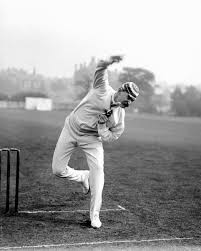On the 9 September 1853, arguably Australia’s finest bowler of the 19 century, Fred Spofforth, was born in the Sydney suburb of Balmain.

The son of Yorkshire-born Edward Spofforth, a bank clerk, and his wife Anna, née McDonnell. Spofforth spent his early childhood in Hokianga, New Zealand and was later educated privately at the Reverend John Pendrill’s Eglinton House on Glebe Road and, for a short time, at Sydney Grammar School.
He was later employed by the Bank of New South Wales as a clerk.
He was the first to take 50 Test wickets, and the first man to take a Test hat-trick in 1879, when Lord Harris‘ England team played on the Melbourne Cricket Ground, dismissing Vernon Royle, Francis MacKinnon and Tom Emmett in three successive deliveries.
He played in Test matches for Australia from 1877-1887, and then settled in England where he played for Derbyshire.

He began his cricketing life as a bowler of under-arm lobs, but changed his style when he saw the English quick bowlers on tour of the colonies in 1863-1864. He decided to pursue the overarm action, and spent years mastering it. Spofforth first became noticed playing for New South Wales, aged 18, when he established a reputation.for his bowling.
Spofforth played his first Test match in 1877 in Melbourne, in the 2nd match of the first-ever Test series, against the English team led by James Lillywhite, Jr., which England won by four wickets.
In 1878, in the 2nd match of the Australian tour against the MCC at Lord’s, the MCC was dismissed twice in one day for scores of 33 and19. The Aussies won by 9 wickets, with Spofforth picking up 10 for 20, after first clean-bowling Grace for a duck.
During the tour Spofforth was credited with 110 wickets at under 11 runs, and a batting average of 13 from 28 innings.
As a consequence of this victory, Spofforth became known as ‘The Demon Bowler’, a title which first adorned John ‘Foghorn’ Jackson in the 1850s. He was the bowler whom English batsmen most feared and is also regarded as the one who first brought into the game, as a scaring technique, eye-to-eye contact with the batsman. Spofforth would often stare straight into the batsman’s eyes to scare and shake him.

A technique which worked particularly well in the match that gave birth to the Ashes series at The Oval in 1882. In their second innings, England required a 85 runs to clinch the match, but Spofforth refused to give up, and led the team to one of the closest victories in the history of Test cricket. The Australians won by 7 runs, with Spofforth taking 14 for 90.
Although not noted as a batsman, he once top-scored in a Test from the unlikely starting position of number eleven. He hit 50 against England at Melbourne in 1884–1885, the next-highest score by an Australian in the match was 35.
Fred Spofforth played his last Test match in Sydney in 1887 in which he bowled 12 overs, conceded 17 runs and for one wicket. England won the match by 13 runs.
In 1888 Spofforth settled in Derbyshire. Yorkshire waived the 2 years’ residential qualification, so that he could play 2 matches for the Derbyshire CCC in 1889 season. Spofforth. In one of these games he took 15 Yorkshire wickets for 81 runs. Spofforth captained the side in 1890.
Derbyshire was found to be in deep financial crisis and Spofforth played a key part in identifying a fraud that had been committed. The cricket club’s losses amounted to £1000 and the Derby County Football Club had also been raided. Samuel Richardson the club’s first captain had become an administrator of the club in 1880, and in 1884 the remit had been extended to the associated Derby County Football Club. Richardson admitted his guilt and fled the country in disgrace and settled in Madrid.
In 1896, Spofforth, playing for MCC aged 43, taking 8 wickets for 74 against Yorkshire. He also played club cricket for Hampstead for some years.
He went into business as a tea-merchant and became the managing director of the Star Tea Company.
Spofforth died from chronic colitis, on the eve of the 1926 Ashes series, at Long Ditton, Surrey. He left a fortune of £164,000.
In 1996 he was posthumously included in the Australian Cricket Hall of Fame as one of 10 inaugural inductees. A sculpture of Spofforth was unveiled at the Sydney Cricket Ground in 2008. And in 2011, he was inducted into the ICC Hall of Fame.
09 September, 2019